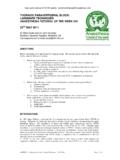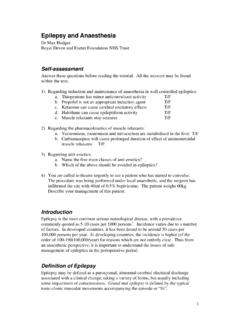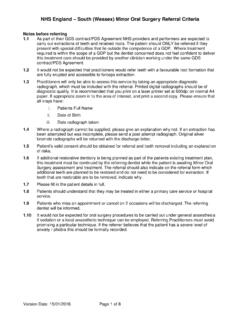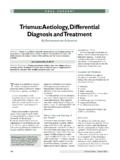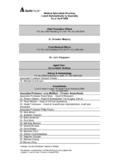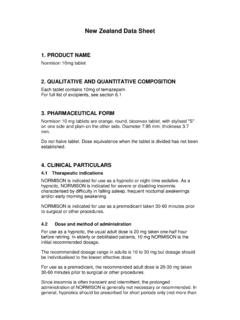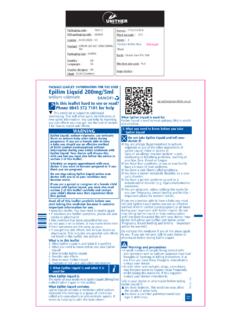Transcription of DELIRIUM IN CRITICAL CARE - Anaesthesia UK
1 Sign up to receive ATOTW weekly - email ATOTW 232 DELIRIUM in CRITICAL care 18/07/2011 Page 1 of 13 DELIRIUM IN CRITICAL care Anaesthesia TUTORIAL OF THE WEEK 232 18TH JULY 2011 Dr David Connor, Registrar, Anaesthesia Dr William English, Consultant, Intensive care Medicine Royal Cornwall Hospital, UK Correspondence to: QUESTIONS Please answer the following questions. The answers can be found within the text and at the end of the article. Which of the following statements are correct? 1. DELIRIUM is a frequent complication of CRITICAL illness. 2. The assessment tools available have not been validated for use in patients who are mechanically validated. 3. Hypoactive DELIRIUM is uncommon.
2 4. Benzodiazepines should be the first line agents for treatment of agitation and DELIRIUM in Intensive care patients. 5. Prophylactic haloperidol has been shown to prevent the onset of DELIRIUM . INTRODUCTION DELIRIUM is a common complication of CRITICAL illness. It has conventionally been regarded as an unavoidable and benign side effect of long-term sedation on an intensive care unit (ICU). However in recent years this pre-conception has been challenged by the publication of studies demonstrating poorer outcomes in ICU patients with DELIRIUM . This article will define DELIRIUM , summarise the risk factors for the development of ICU DELIRIUM , provide an overview of the current evidence base for its detection and discuss the management of DELIRIUM in intensive care patients.
3 DEFINITON & CLASSIFICATION The American Psychiatric Association defines DELIRIUM as a disturbance of consciousness, attention, cognition and perception which develops over a short period of time (usually hours to days) and tends to fluctuate during the course of the day .1 DELIRIUM can be sub-classified according to aetiology using the DSM IV criteria. This is difficult to apply to the CRITICAL care population in whom a multifactorial origin is likely. A more useful clinical classification system was first described in elderly patients by Lipowskiin Three sub-types of DELIRIUM were described. Hypoactive DELIRIUM Patients appear subdued, withdrawn and have a poor response to stimulus Hyperactive DELIRIUM Patients may display agitation or aggression and may experience delusions or hallucinations Mixed DELIRIUM Patients fluctuate between hypo and hyperactive subtypes Ouimet et al first defined sub-syndromal DELIRIUM in a patient sub-group who displayed some features of DELIRIUM but didn t meet the full diagnostic criteria.
4 This introduced the concept of DELIRIUM as a spectrum of disease rather than a single RISK FACTORS Numerous risk factors have been identified for the development of DELIRIUM on the ,5,6,7 They are summarised in Table 1. Sign up to receive ATOTW weekly - email ATOTW 232 DELIRIUM in CRITICAL care 18/07/2011 Page 2 of 13 Table 1: Risk factors for DELIRIUM on ICU Medical history Age over 70 Hypertension Congestive cardiac failure Stroke Epilepsy Depression Dementia HIV Renal impairment Hepatic impairment Visual or hearing impairment Social history Smoker Alcohol abuse Malnutrition Environmental Physical restraints Rectal or urethral catheter Central venous catheter Sleep deprivation Acute presentation Disease severity (APACHE II score)
5 Metabolic derangement o Thyroid function o Glycaemic control o Hyper/hyponatraemia o Renal function Thermoregulation Sepsis Hypoxaemia Anxiety Uncontrolled pain Medications Use of an epidural Opiates Benzodiazepines Propofol Anti-cholinergics DIAGNOSIS DELIRIUM was traditionally diagnosed by a psychiatrist using DSM IV criteria. Whilst psychiatric referral can still be helpful, the development of specific DELIRIUM assessment tools for use by the multi-disciplinary team has greatly improved its recognition on intensive care . However DELIRIUM is probably still under-diagnosed, particularly in the hypoactive sub-type, where the more subtle features may be overlooked.
6 The assessment tool most commonly employed in UK clinical practice is the Confusion Assessment Method for the Intensive care Unit (CAM-ICU).8 Both CAM-ICU and the Intensive care DELIRIUM Screening Checklist (ICDSC) have been specifically validated for use on the intensive care 1 & 2 illustrate how these assessment tools are conducted. Both are easy and quick to perform and have good inter-observer CAM-ICU, performed once every 24 hours, directly assesses the patient performing tasks to command and can be used during mechanical ventilation. ICDSC, documented every 8 hours, is more subjective as it relies on data collected during routine nursing care without direct assessment of the patient.
7 Patients who are experiencing isolated hallucinations may be assessed as DELIRIUM negative by CAM-ICU but DELIRIUM positive by ICDSC. Both CAM-ICU and ICDSC have been shown to have a high sensitivity (97%9&99%10 respectively) but CAM-ICU has a much better specificity (99%9) than ICDSC (64%10). Another study, which directly compared the performance of the two scoring systems, suggested a good level of agreement between INCIDENCE For many years, the lack of a consistent definition for DELIRIUM that could be applied to intensive care patients hampered efforts to determine its incidence in this setting. The development of the two DELIRIUM screening tools discussed has Sign up to receive ATOTW weekly - email ATOTW 232 DELIRIUM in CRITICAL care 18/07/2011 Page 3 of 13 gone some way to address this issue.
8 However reported incidence still varies widely ( ) depending on the patient demographics, illness severity and screening tool ,10 DSM IV One study in 2001 suggested that the incidence of DELIRIUM , when assessed by two independent psycho-geriatricians using DSM-IV criteria, was as high as in the 48 study During validation of the ICDSC, a psychiatrist identified DELIRIUM in of 93 study patients using DSM IV CAM-ICU The pilot for the CAM-ICU assessment tool found a high incidence of in 111 study Subsequent studies using CAM-ICU suggest that the incidence varies between 41-74%.6,13 This is in comparison to the data from our local mixed surgical and medical ICU in which CAM-ICU screening detected DELIRIUM in of patients at some point in their Peterson et al noted that the most common DELIRIUM subtypes were mixed ( ) and hypoactive ( ) whilst hyperactive was found to be relatively uncommon ( ).
9 15 ICDSC Ouimet et al7 identified DELIRIUM in of 764 patients in a mixed specialty intensive care unit using the ICDSC tool. Whatever the true incidence of DELIRIUM is, it appears to be much more common than previously thought and the introduction of validated assessment tools has improved the recognition of this important condition. PATHOPHYSIOLOGY Currently there is no comprehensive explanation for the mechanism by which DELIRIUM occurs in the critically ill. There are however numerous hypotheses and it seems likely that its pathophysiology is multifactorial. An excellent review by Girard et al16 covers several of the leading suggestions and these are summarised in Figure 1 (adapted from Figueroa-Ramos et al17): 1.
10 Increased levels of dopamine and reduced levels of acetylcholine are thought to increase neuronal excitability and precipitate DELIRIUM . These changes may be caused by changes in the synthesis, release and inactivation of these neurotransmitters. Whether other neurotransmitters (such as GABA, endorphins, glutamate or histamine) are also involved is unknown. 2. Tryptophan is an amino acid which is actively transported across the blood brain barrier via LAT1 proteins. It is a precursor for serotonin and subsequently melatonin production. Low levels of tryptophan, and thus serotonin and melatonin, are hypothesised to cause hyperactive DELIRIUM .


